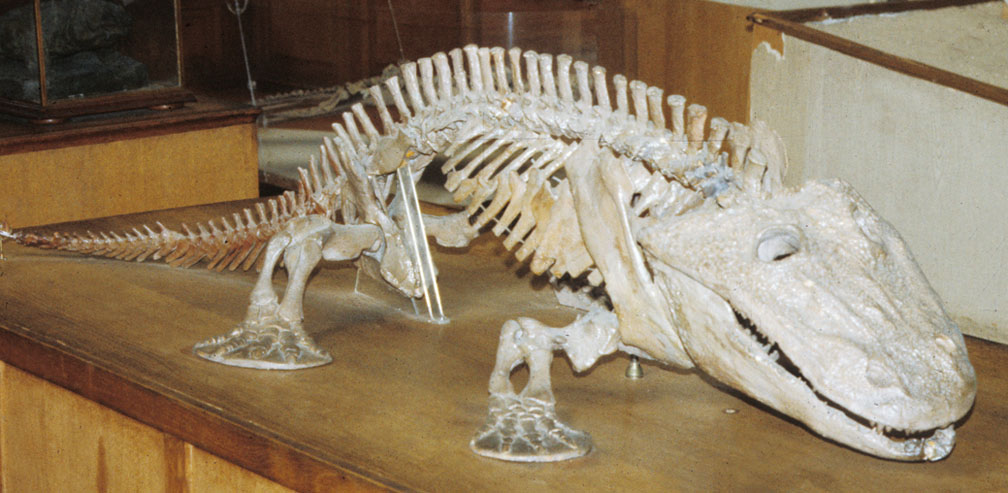Natural Antacid Helped Early Land Creatures Breathe

The earliest creatures to crawl out of the water onto land may have concocted antacids out of their own bones, a clever innovation that would've let the animals breathe, researchers now find.
The earliest tetrapods, or four-limbed creatures, made their first evolutionary forays onto land about 370 million years ago. Breathing air came with challenges, though. A major one was getting rid of the air's carbon dioxide, which, when it builds up, reacts with water in the body and forms an acid.
Now, growing evidence in modern reptiles suggests that bones that grew within the skin of early tetrapods may have acted as a natural antacid by releasing their neutralizing chemicals into the bloodstream. The result would have bought the creatures time to spend on land before they had to head back to the water to rid themselves of excess carbon dioxide.
"Now we know that dermal bone can do this and it's something we didn't know before, that gives us a basis that maybe this is why tetrapods had this feature, which previously we didn't have a good explanation for," study researcher Christine Janis, a paleontologist at Brown University, told LiveScience. "It's the discovery of this new feature of the physiology of these living animals that lets us go back [in time]."
First on land
So let's rewind the clock: The first tetrapods evolved from fish in the Devonian period, which spanned from about 416 million years ago to 359 million years ago. These early tetrapods had broad faces, not unlike frogs, and rather immobile ribcages. That means they wouldn't have been able to get rid of extra carbon dioxide by breathing quickly, as humans and other mammals do with their longer snouts and flexible ribcages. Nor were the tetrapods small enough to exchange carbon dioxide and oxygen via their skin, as modern amphibians do. [Top 10 Useless Body Parts]
What tetrapods did have was complex "dermal bone," or bone that forms from connective tissue in the skin instead of from cartilage like the long bones of the arm or leg.The concept of skin bone may seem strange, but it's very common: The human skull, for example, is a dermal bone.
Sign up for the Live Science daily newsletter now
Get the world’s most fascinating discoveries delivered straight to your inbox.
Early tetrapod bone showed many pits and furrows, indicating lots of blood supply, Janis said. Her colleagues, including paper co-author and biologist Daniel Warren of Saint Louis University, had found another piece of the puzzle: In modern turtles and alligators, this dermal bone helps the reptiles tolerate carbon dioxide buildup when they're under water, unable to breathe.
Bone breathing
Tetrapods would have the opposite problem, Janis realized: They'd be able to release carbon dioxide through their skin while in the water, since their skin was more permeable than an alligator's tough hide. But out on land, they'd need another means of release. It seemed very possible that tetrapods could have used their complex dermal bones as a storage unit for calcium and other acid-neutralizing minerals, releasing them as needed when body acid levels got too high, Janis said.
To test the idea, the researchers analyzed the skeletons of tetrapods. As you might expect, the tetrapods known by the skeletons to spend more time out of the water had the most complex dermal bones. The evolutionary history of the animal supports the hypothesis, as well.
"When [the dermal bone] gets lost, it gets lost in the lineage leading to modern reptiles when they start getting more mobile ribs," Janis said.
She and her colleagues reported their work Tuesday (April 24) in the journal Proceedings of the Royal Society B.
End of the early tetrapods
While the evidence is consistent with Janis' theory, there's no proof yet that tetrapods really used their bones in this way. The next step, Janis said, will be to look for chemical or other clues in modern reptiles who use their bones as antacid. If any telltale signs are established, researchers can then hunt for the same signals in ancient tetrapods.
The terrestrial tetrapods studied by Janis and her colleagues went extinct during the Permian period 299 million to 251 million years ago. It was a changing world, Janis said, and atmospheric carbon dioxide was increasing. It's possible that tetrapods' bone-dependent breathing wasn't as effective in this new atmosphere.
"Who knows?" Janis asked. "I think the point to make is that this was probably a perfectly good way to live for awhile — millions of years — but in the end, there were things that had figured out better ways of how to get rid of carbon dioxide."
You can follow LiveScience senior writer Stephanie Pappas on Twitter @sipappas. Follow LiveScience for the latest in science news and discoveries on Twitter @livescience and on Facebook.

Stephanie Pappas is a contributing writer for Live Science, covering topics ranging from geoscience to archaeology to the human brain and behavior. She was previously a senior writer for Live Science but is now a freelancer based in Denver, Colorado, and regularly contributes to Scientific American and The Monitor, the monthly magazine of the American Psychological Association. Stephanie received a bachelor's degree in psychology from the University of South Carolina and a graduate certificate in science communication from the University of California, Santa Cruz.









